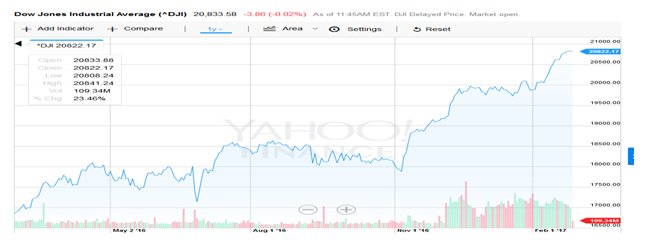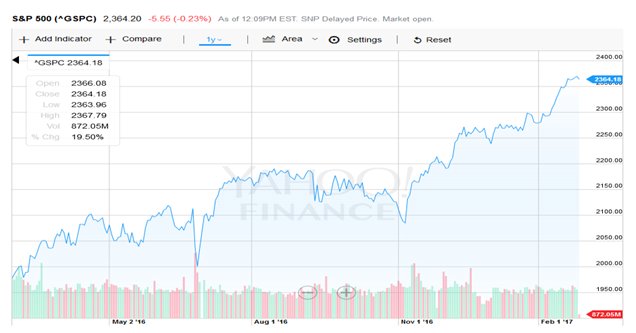Comptroller Kevin Lembo Archive > News
COMPTROLLER LEMBO PROJECTS $11.8-MILLION SURPLUS WITH CAUTIONComptroller Kevin Lembo today announced that the state is currently on track to end the fiscal year with an $11.8-million surplus, but Lembo warned that this surplus relies on an optimistic view that final income tax payments in April will outperform estimated income tax payments collected so far.
In a letter to Gov. Dannel P. Malloy, Lembo said that, once again, his own projected surplus is slightly lower than the Office of Policy and Management’s (OPM) due to a variance in what they believe the cost will be this fiscal year for ongoing settlement payments in the SEBAC vs. Rowland case.
Lembo's projection reflects Jan. 17 consensus revenue - a revenue projection agreed to by OPM and the legislature’s nonpartisan Office of Fiscal Analysis - that projects overall General Fund revenue will exceed the budget plan by $10.8 million.
However, Lembo raised concerns once again about how the forecast relies on strong April income tax receipts related to strong stock market activity late in the 2016 tax year.
“I am concerned that the January consensus forecast relies on strong April income tax receipts,” Lembo said. “Estimated income tax payments through January were below last fiscal year’s receipts. Typically, final April payments trend in the same direction as estimated payments. However, because of stock market corrections and subdued bonus payments in the 2015 tax year, a large number of taxpayers may be eligible to utilize safe harbor provisions of the tax code. The safe harbor provisions allow taxpayers to delay the payment of their full 2016 tax liability until April of 2017 (rather than incorporating them into their fourth-quarter estimated payments).
“This would help to explain why estimated payments remain negative despite a strong stock market run-up in the final months of the 2016 tax year. As I noted last month, in addition to the uncertainty with respect to the final income tax payments in April, the growth in the payroll-driven withholding portion of the income tax has been slowing. Therefore, income tax receipts remain a significant risk factor to the small surplus projections.”
Lembo projects that General Fund spending will exceed the budget by approximately $21.7 million and noted that “continued active budget management will be required to keep the General Fund in balance.”
"Connecticut’s overall budget performance is ultimately dependent upon the performance of the national and state economies,” Lembo said. “The January labor situation report for Connecticut will not be released by the Department of Labor until March 10. Therefore, we continue to report the December labor data.”
Lembo pointed to latest available economic indicators from federal and state Departments of Labor and other sources that show:

• In Fiscal Year 2016 the withholding portion of the income tax increased 3.4 percent from the prior fiscal year. Through January of Fiscal Year 2017, these receipts were up 2.3 percent from last year. Adjusting for timing differences between fiscal years in deposit days by month, the withholding tax trend has been running below last fiscal year and decelerating in recent months.
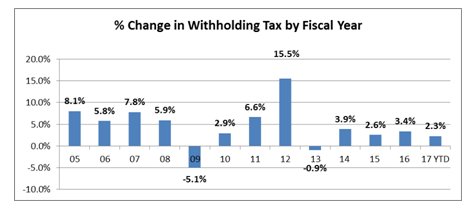
• The January labor situation report will not be released by the Department of
Labor until March 10. Therefore, the data below is from last month’s report.
• Preliminary Connecticut nonfarm job estimates from the business establishment
survey administered by the U.S. Bureau of Labor Statistics (BLS) show the state
lost 1,700 payroll jobs in December 2016 to a level of 1,678,000, seasonally
adjusted. November’s initial job gain figure of 2,100 jobs was adjusted down to
show a gain of 1,900 jobs.
• The establishment survey indicates that the state has lost 2,000 payroll
positions over the past 12-month period ending in December. It should be noted
that this survey has been subject to major revisions in past years when it has
been benchmarked for the full calendar year. The 2016 revisions will be released
by BLS on March 13.
• Other data, including withholding receipts and the household census survey,
indicate Connecticut’s job performance has been better than the establishment
survey has indicated. The household survey shows Connecticut adding almost 4,000
jobs in December and up almost 32,000 jobs for the 2016 calendar year.
• Based on the establishment survey, Connecticut has now recovered 70.4 percent
or 83,800 of the 119,100 jobs lost to the Great Recession.
• As the state’s employment recovery has progressed, an increasing number of job
sectors have posted employment gains. However, this month’s data from the
establishment survey has reversed some of the strong sector-wide gains that had
been recorded over the past many months. The actual results will not be known
until benchmarking is completed.
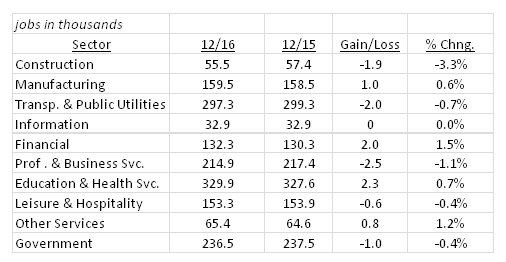
• U.S. employment has been advancing at a rate of 1.5 percent over the
12-month period ending in December; Connecticut’s employment growth pending
final benchmark adjustment was a negative 0.1 percent during that period.
• Connecticut’s unemployment rate was 4.4 percent in December (which comes from
the household survey that has been showing job gains in Connecticut); the
national unemployment rate was 4.7 percent. The declining unemployment rate this
month is another artifact of the inconsistency in Connecticut data between the
establishment employment survey and the household survey. Connecticut’s
unemployment rate has continued to decline from a high of 9.5 percent in October
2010.
• There were 83,500 unemployed job seekers in Connecticut in November. A low of
36,500 unemployed workers was recorded in October of 2000. The number of
unemployed workers hit a recessionary high of 177,200 in December of 2010.
• All of the employment and related data must be considered in light of the
erosion in the state’s total population over recent years. According to U.S.
census data, Connecticut saw a decline in population of 8,278 residents between
July 1, 2015 and July 1, 2016. Connecticut was one of only eight states to
experience a decline in population during this period. Connecticut has now
posted three consecutive years of population decline
![]()
• Average hourly earnings at $30.59, not seasonally adjusted, were up $0.79, or
2.6 percent, from the December 2016 hourly earnings estimate. The resultant
average private-sector weekly pay amounted to $1,030.88, up $29.60, or 3 percent
higher than a year ago.
• Connecticut ranked 11th nationally in income growth for the third quarter of
2016 based on personal income statistics released by the Bureau of Economic
Analysis on Dec. 20. Among the New England states, only Massachusetts and New
Hampshire outpaced Connecticut’s growth. Connecticut’s annualized personal
income growth based on third-quarter results was 4.9 percent. While this is
still off the pace of the last recovery period, it continues a recent pattern of
quarterly improvement.
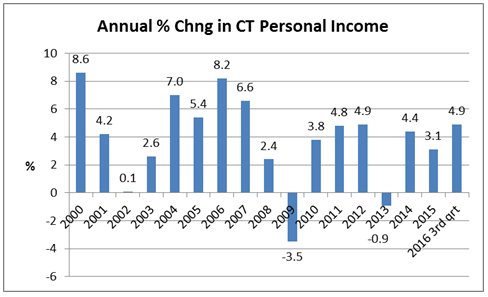
• Personal income statistics for fourth-quarter personal income growth will
be released on March 28.

• According to a Feb. 22 release from CT Realtors, Connecticut single-family
residential home sales increased 14.2 percent in January 2017 from the same
month a year earlier. The median sale price also posted an increase of 2.2
percent to $235,000. Connecticut has been in a sustained period of sales volume
gains since 2012; however, prices have only recently rebounded. Townhouse and
condominium sales increased 23.7 percent in January and prices increased 4.4
percent to $155,000.
• The National Association of Realtors (NAR) reported that U.S. sales of
existing homes including condominiums expanded 3.3 percent to a seasonally
adjusted annual rate of 5.69 million in January from an upwardly revised 5.51
million in December 2016. January's sales pace is 3.8 percent higher than a year
ago (5.48 million) and surpasses November 2016 (5.60 million) as the strongest
since February 2007 (5.79 million). The median existing-home price for all
housing types in January was $228,900, up 7.1 percent from January 2016
($213,700). January's price increase was the fastest since last January (8.1
percent) and marks the 59th consecutive month of year-over-year gains.
Consumers
• Retail spending growth advanced 0.4 percent in January from the previous
month, and 5.6 percent from January of 2016. December’s spending number was
revised up from 0.6 percent to a very strong 1 percent figure.
• The spending gains were broad based, with most retail sectors posting solid
gains. The most notable exception to the sales growth pattern was department
store sales that fell 3.2 percent on a year-over-year basis. According to a Pew
Research Center study that was released in December, the percent of Americans
that shop on-line is now 79 percent up from 22 percent in 2000. Consistent with
that finding, non-store retailers recorded a sales gain of 12 percent from
January of last year.
• Car sales have experienced strong gains on a year-over-year basis, but they
have declined slightly between December and January.
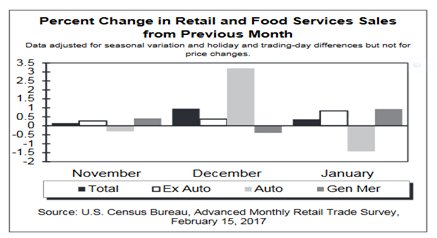
• Consumer confidence fell for the first time since the election, according
to the University of Michigan's bimonthly survey.The sentiment index in February
fell to 96.3 from a January reading of 98.5, which was the highest in a decade.
Economists had forecast a reading of 96.
• The current conditions index, which measures Americans’ perceptions of their
personal finances, rose to 111.5 from 111.3 in the prior month. The gauge of
expectations six months from now dropped to 86.5 from 90.3 in January.
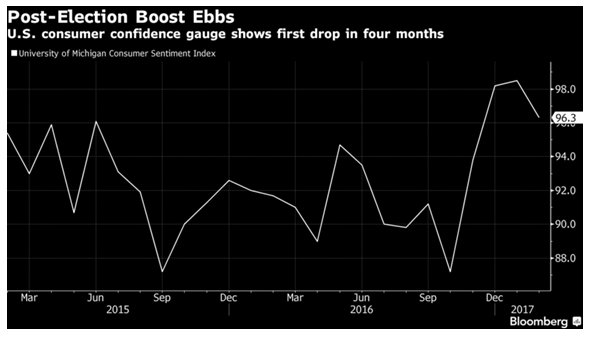
• According to TransUnion’s Industry Insight report, the number of consumers
with access to credit products increased by 12 million, and balances rose across
all products. Marking the highest level since the third quarter of 2009, 80
million consumers had an auto loan or lease outstanding at the end of 2016.
Personal loans topped $100 billion for the first time ever. On the downside of
these figures, the auto delinquency rate reached 1.44 percent by year-end, a
13.4-percent increase since the end of 2015 and its highest level since 2009.
The personal loan delinquency rate was 3.83 percent, up from 3.62 percent in the
fourth quarter of 2015.
• The average mortgage balance reached a post-recession high of $194,415.
Mortgage originations reached 2.23 million in the third quarter of 2016, the
highest level in three years, and mortgage delinquencies continued to decline,
as they have since 2013. They ended the year at a delinquency rate of 2.28
percent, which may be a natural floor.
• The Federal Reserve Bank reported on Feb. 7 that consumer credit expanded at a
seasonally adjusted annual rate of 4.5 percent in December. The growth was more
subdued than had been expected for the month. Looking at the entire fourth
quarter 2016 results, consumer credit advanced at a 6-percent rate.
Business and Economic Growth
• According to the Feb. 28 second estimate from the Bureau of Economic
Analysis, real GDP in the fourth quarter of 2016 grew at a 1.9 percent annual
rate. This is the same growth rate that was reported in the advanced January
estimate. The growth rate in the third quarter was 3.5 percent.
• The deceleration in real GDP in the fourth quarter reflected a downturn in
exports, an acceleration in imports, and a downturn in federal government
spending that were partly offset by an upturn in residential fixed investment,
an acceleration in private inventory investment, an upturn in state and local
government spending. The economy has settled into a pattern of 2 percent GDP
growth since the end of the 2008 recession.
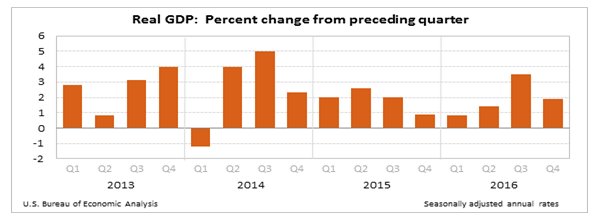
• Corporate profit results for the fourth quarter will be released on March 30.
Corporate profit continued rebounding in the third quarter. Profits rose 5.8
percent on a quarterly basis and were 2.1 percent above the third quarter of
last year.
• Third-quarter earnings gains were led by technology, utilities, basic
materials, financial and consumer-discretionary companies. Real estate, health
care and financials showed the most improvement in revenue.
• Corporate profits have been constrained in recent years by various forces,
including weak global growth, a strong dollar, and slumping commodity prices
that contracted the energy and agriculture sectors. But business earnings have
shown signs of stabilization this year as some of those past pressures have
weakened.
• According to the Commerce Department’s Feb. 27 report, durable goods
orders—products designed to last longer than three years, such as machinery or
minivans—rose sharply in January after a December decline. Orders were up 1.8
percent in January after a 0.8 percent decrease in December.
• Orders for non-military capital goods excluding aircraft – a proxy for future
business investment – unexpectedly fell 0.4 percent after a 1.1-percent jump in
the prior month. Growth had been advancing at a three-month moving average of
0.8 percent prior to January, which annualizes to a rate of just over 8.5
percent.
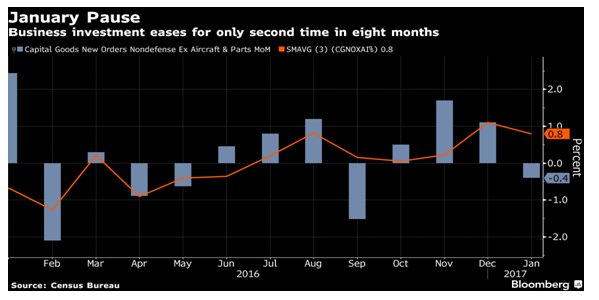
• Orders for transportation equipment were up by 6 percent in January after
tumbling by 4.4 percent in December. Orders for defense aircraft and parts and
non-defense aircraft and parts soared by 59.9 percent and 69.9 percent,
respectively.
• The service-sector, which is the largest sector of the economy, continued on a
positive growth trajectory in February, although somewhat slower than the
January results. February’s index was at 54.3 down from a 14-month high of 55.8
in January. A reading above 50 indicates sector expansion.
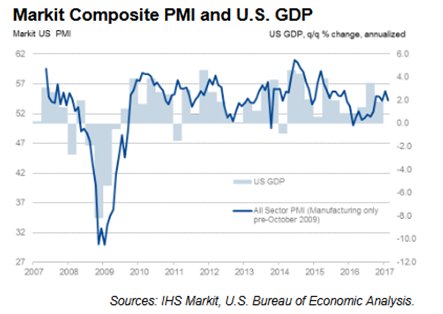
• The Connecticut Economy's General Drift Indicators are composite measures of the four-quarter change in three coincident (Connecticut Manufacturing Production Index, nonfarm employment, and real personal income) and four leading (housing permits, manufacturing average weekly hours, Hartford help-wanted advertising, and initial unemployment claims) economic variables, and are indexed so 1986 = 100.
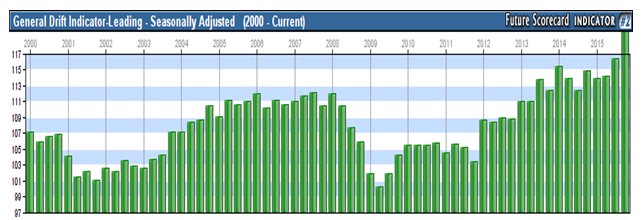
Stock Market
• Estimated and final income tax payments account for approximately 40
percent of total state income tax receipts. Both the estimated and final
payments had a negative rate of growth in Fiscal Year 2016.
• The two large estimated income tax payments for Fiscal Year 2017 have been
deposited. Estimated payments through January were down 9.2 percent from last
year. As can been seen from the graph, it is typical for final income tax
payments to follow the direction of estimated payments. The bulk of final
payments will not be received until April so the slightly positive trend through
January is not especially constructive.
• Current consensus revenue estimates rely on positive growth in final income
tax payments in Fiscal Year 2017. Because of the suppressed tax liability in the
2015 tax year due in part to significant stock market corrections, it is assumed
that taxpayers may apply safe harbor provisions to delay the payment of their
full 2016 tax liability until April.

